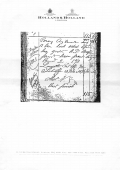Holland & Holland, 98 New Bond Street,
London
12 bore 'Needham Patent' Back Action, Sidelock Ejector
no. 11570
Date of manufacture: 1886
Click on these images for more detail.
|
Heritage Guns' Comment This gun is an extremely rare and very early ejector
from this preeminent gun maker and furthermore is in unusually
fine condition. We know that the gun was sleeved in 1974 by Westley
Richards of Birmingham and we suspect that the stock and forend
wood is the original, judging from its similarity to the original
specification in the maker's records. The original stocking was
executed by John Robertson of Boss & Co fame and the actioning
by Drydon. The inset comb seemed to be an antique alteration,
probably to change the angle of the front of the comb, and has
been refitted by our stocking specialist to a more normal dimension. WE REGRET THAT THIS GUN IS NOW SOLD. IF YOU ARE SEARCHING FOR A SIMILAR GUN, PLEASE CONTACT US. |
The action is of Needham's design
and features:
Double triggers bolted by an automatic top tang
safety slide,
Back action locks,
Westley Richards style top lever opening with a 'dolls head' rib extension,
Needham's patent ejector and split extractors
and Anson's push rod forend catch.
Gun weight 7lb 2oz
Engraving style Best Bouquet & Fine Scroll.
Trigger pulls measure approximately: Front trigger 5 lbs Rear
trigger 5 lbs
The Damascus to Steel TIG sleeved barrels are 28" in length,
chambered for 2 3/4" (70mm) cartridges and are of brazed 'dovetail'
lump construction with soft soldered ribs. Top rib is of the smooth,
flat, pigeon gun type.
London reproof for 70mm nitro powder cartridges in 2008.
Approximate barrel measurements at date of publication:
|
Nominal Proof Size
|
Bore Diameter 9" from Breech
|
Minimum Wall Thickness
|
Choke Constriction
|
|
| Right Barrel |
18.5mm (0.729")
|
0.731"
|
0.033" Minimum
|
0.010" (1/4)
|
| Left Barrel |
18.5mm (0.729")
|
0.729"
|
0.029" Minimum
|
0.025" (5/8)
|
Straight Hand Stock and Splinter Forend are crafted from highly figured walnut. We suspect that the stock and forend wood is the original, judging from its similarity to the original specification in the maker's records. The original stocking was executed by John Robertson of Boss & Co fame. There is an antique adjustment/repair inlet to the front third of the comb and two small repair inlets to the forend wood. The stock is cast off for a right-handed shot and if fitted with a leather covered recoil pad.
The 24 lines per inch chequering
is to normal sidelock pattern that closely follows the outline of the
lock plate.
The stock is finished with a traditional linseed oil based preparation
as used on best guns by one of the top English makers. This finish uses
no grain fillers to achieve its deep, smooth lustre, only many hours
of alternate build and flatting off of the surface.
Approximate stock measurements at date of publication:
|
Pull to Heel
|
Pull to Bump
|
Pull to Centre
|
Pull to Toe
|
|
14 5/16"
|
14 1/2"
|
14 7/16"
|
14 3/4"
|
|
Drop at Comb
|
Drop at Face
|
Drop at Heel
|
|
1 1/2"
|
1 5/8"
|
2"
|
|
Cast at Comb
|
Cast at Heel
|
|
1/8" (approximate)
|
3/16" (approximate)
|
For the purposes of these measurements,
'Drop at Face' is the 'drop' measurement taken on a line perpendicular
to the
line joining the trigger and centre of the butt at approximately 8"
from the trigger (front trigger on a double trigger gun).
Patents Exhibited include:
Joseph Needham's ejector & extractor patent
no. 1204 of 1874,
Westley Richards's bolting patent no. 1572 of 1871,
Stanton's rebounding lock patent no. 367 of 1867,
Anson's forend fastener patent no. 3791 of 1872.







